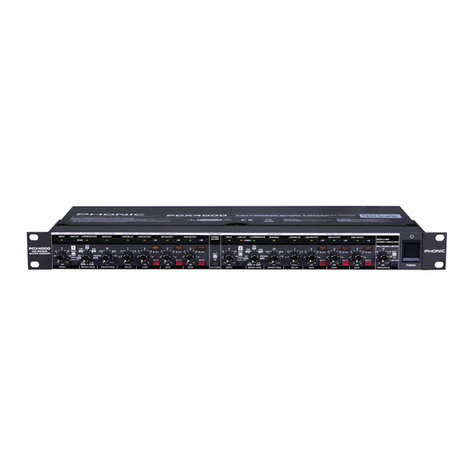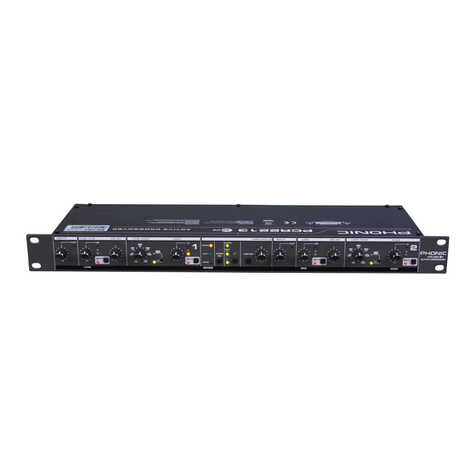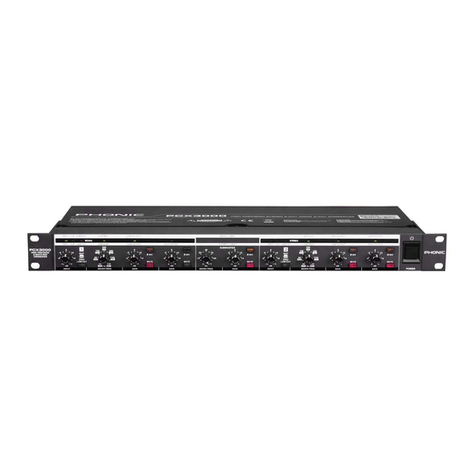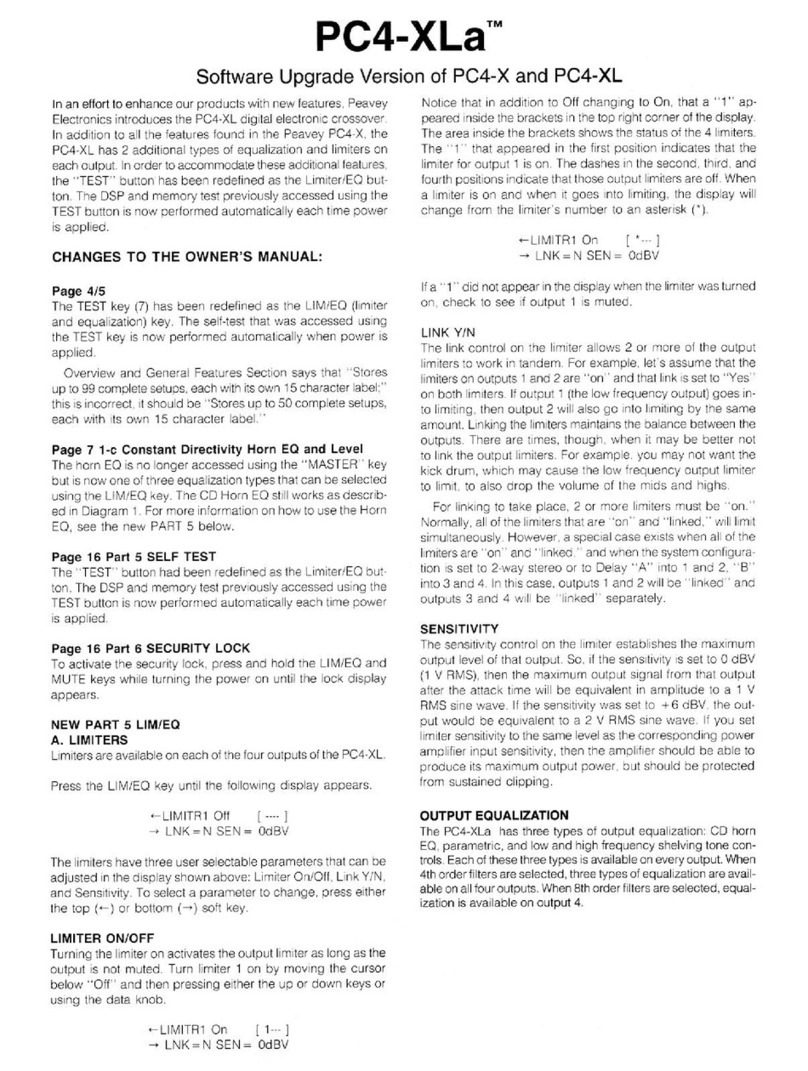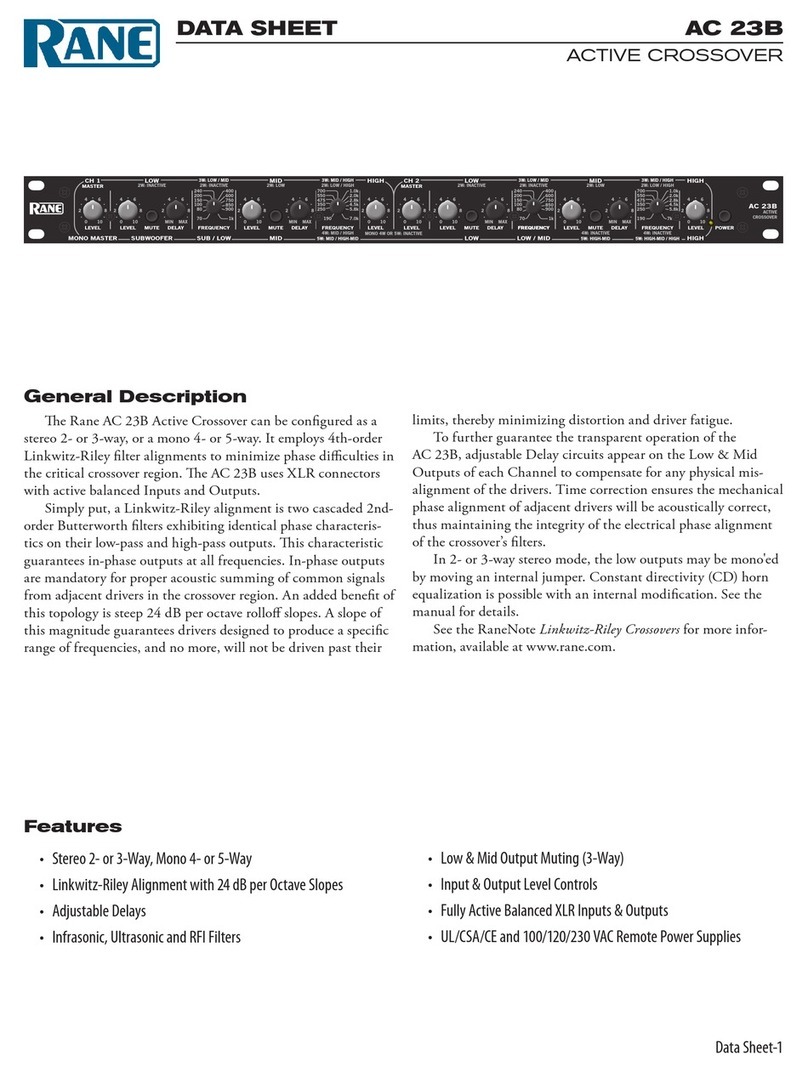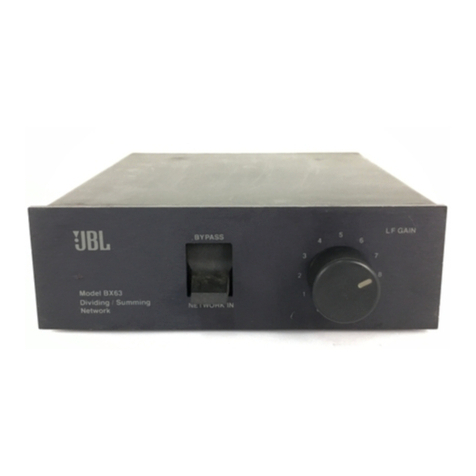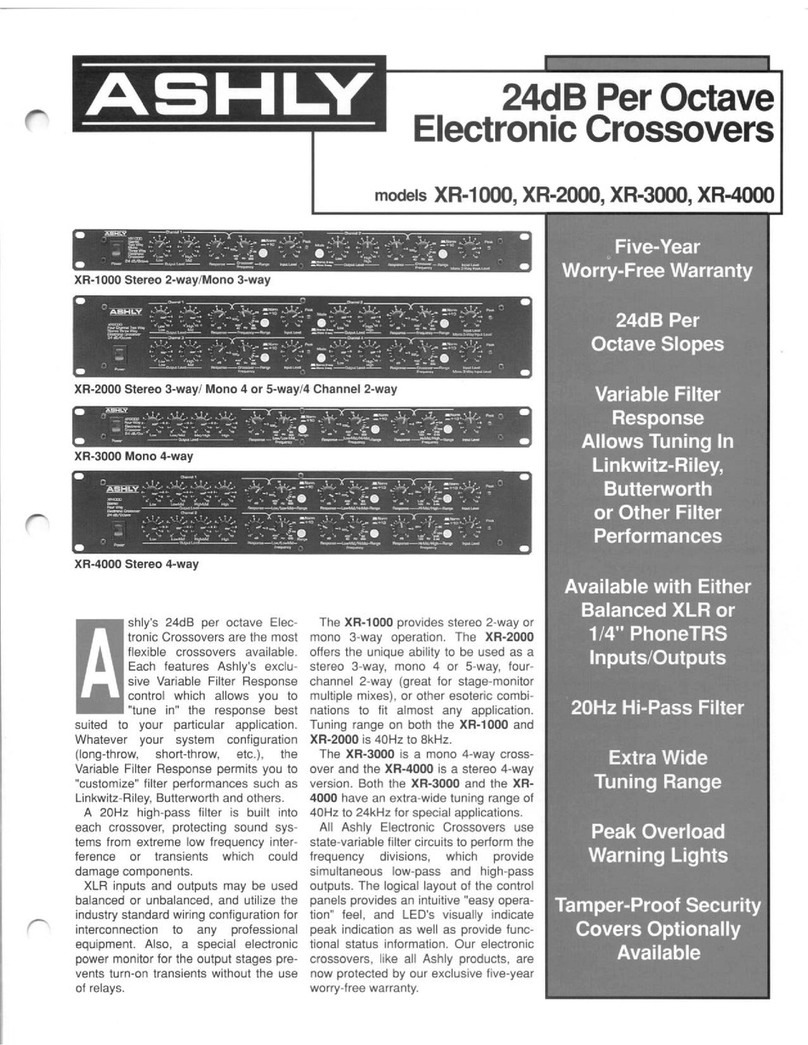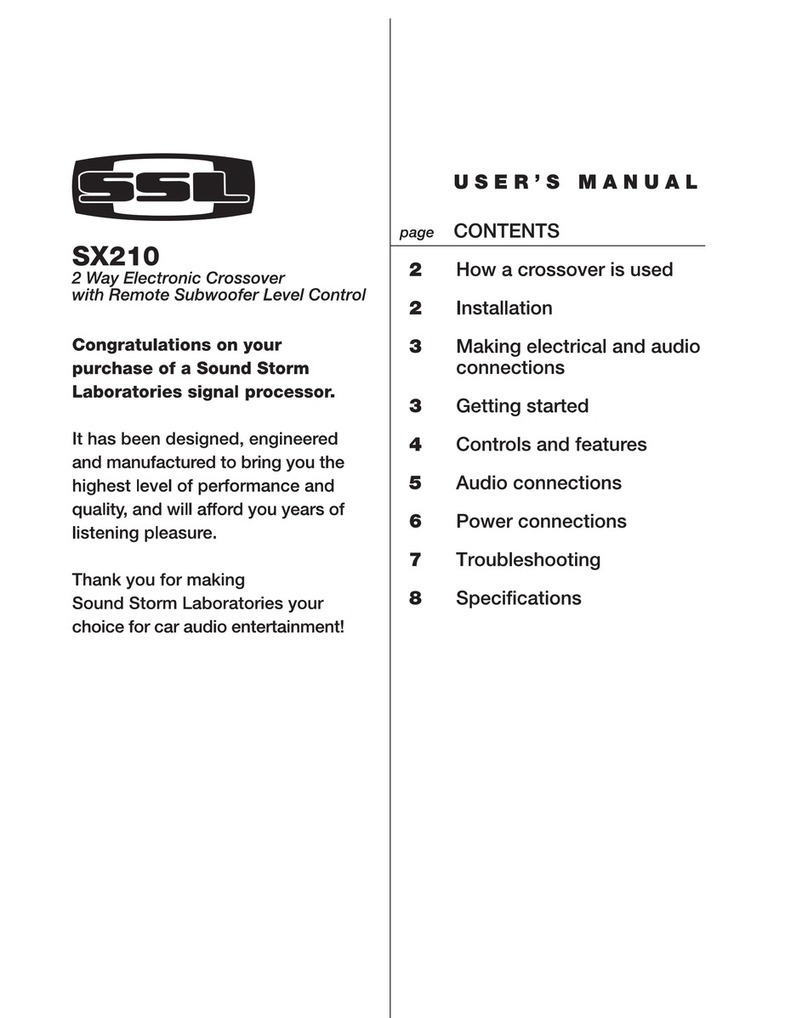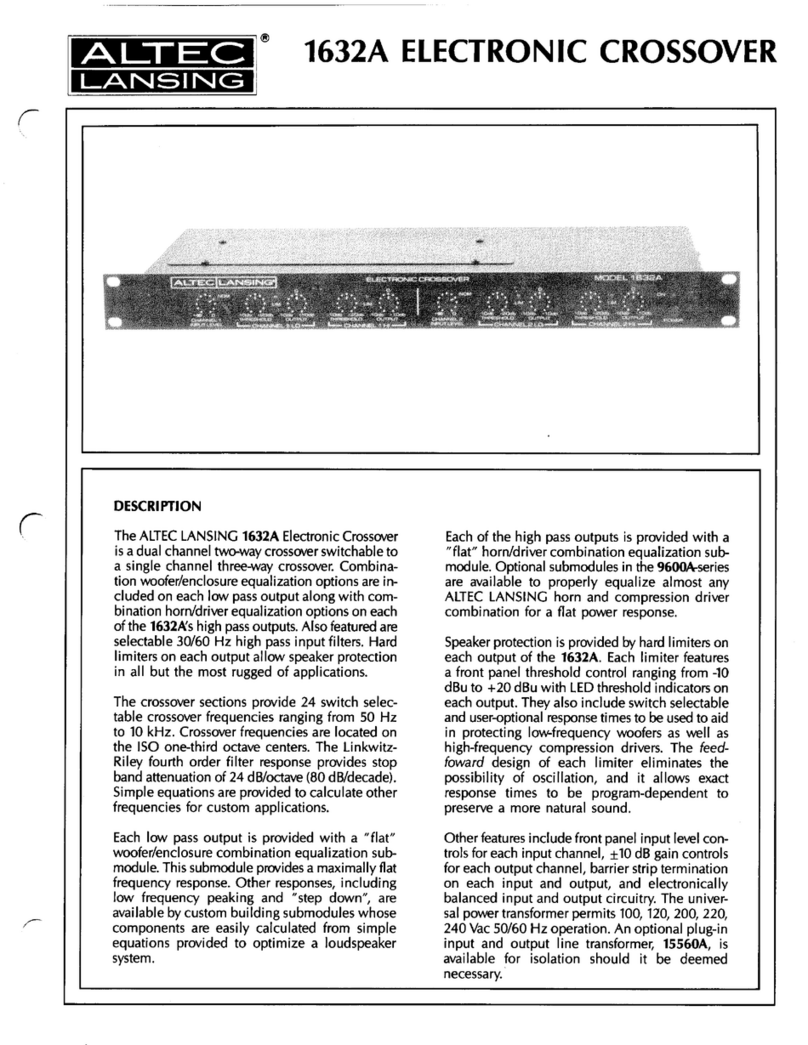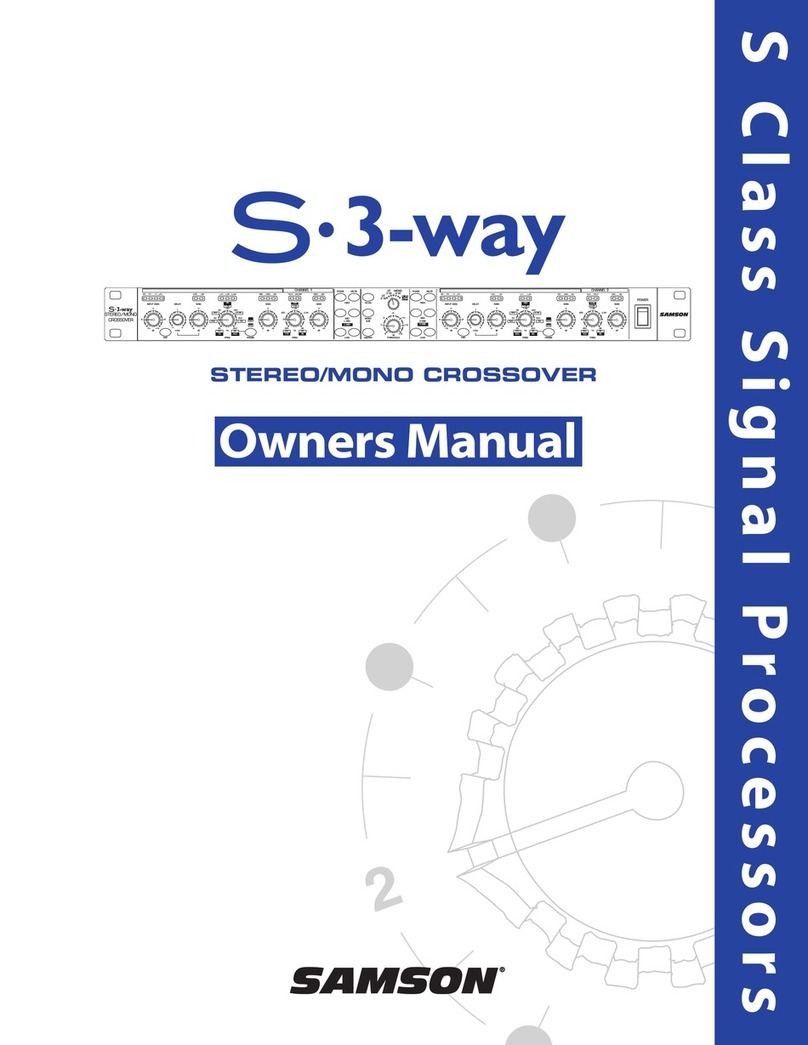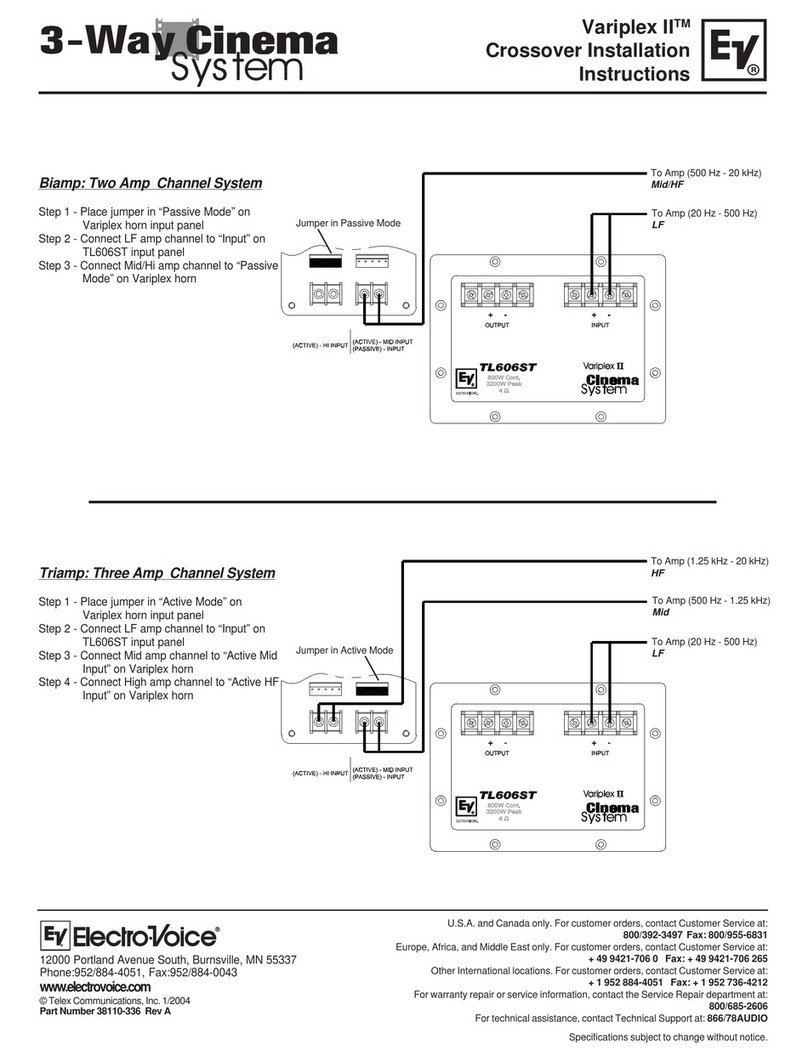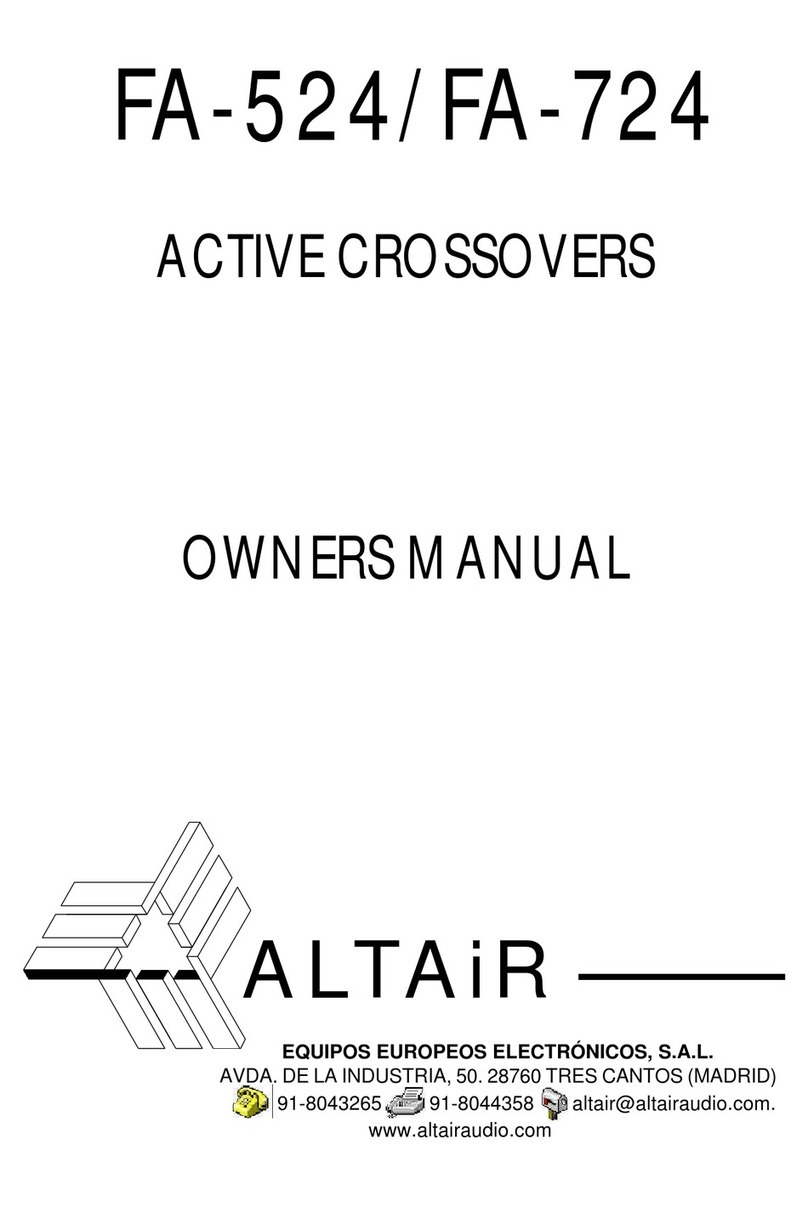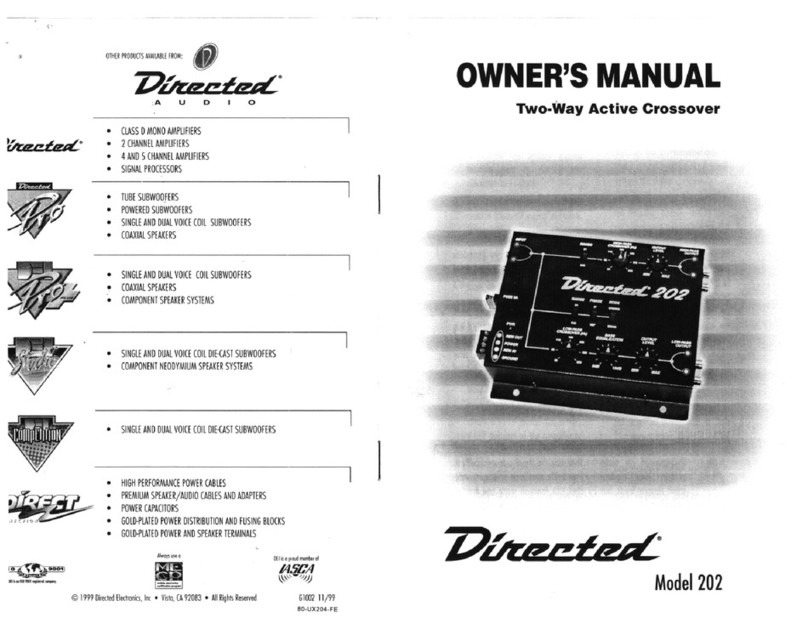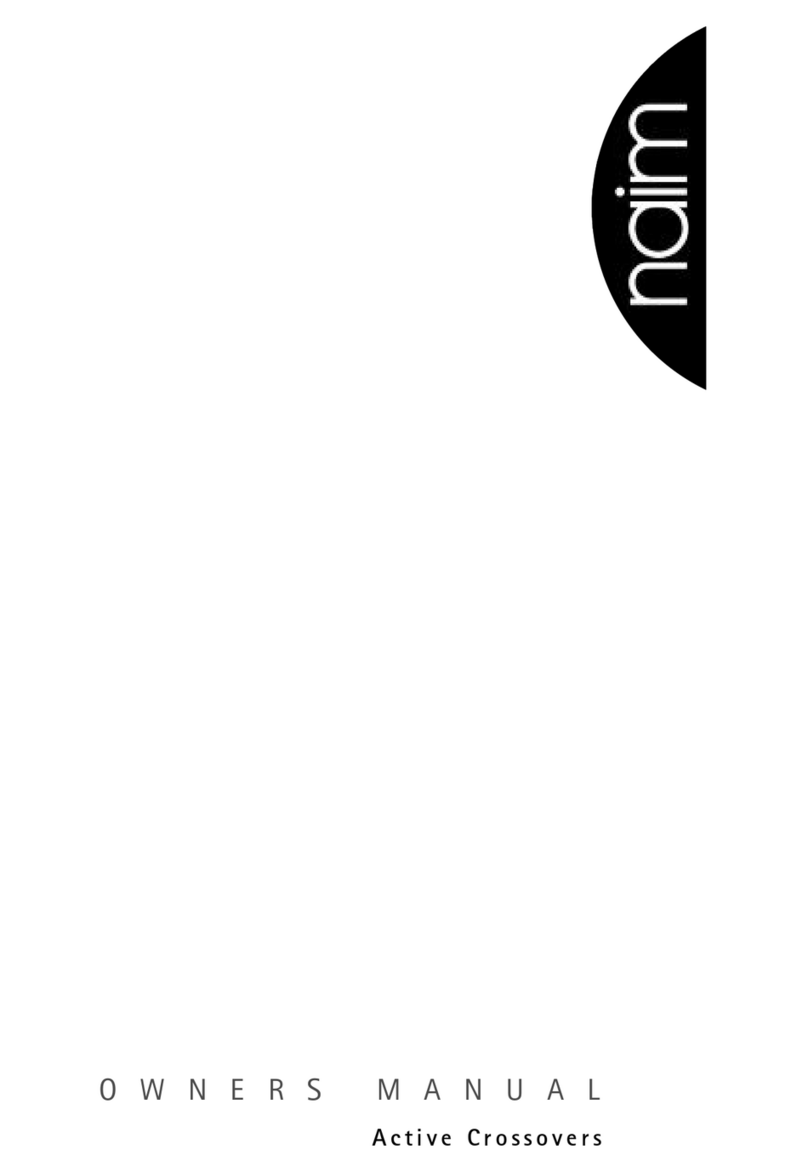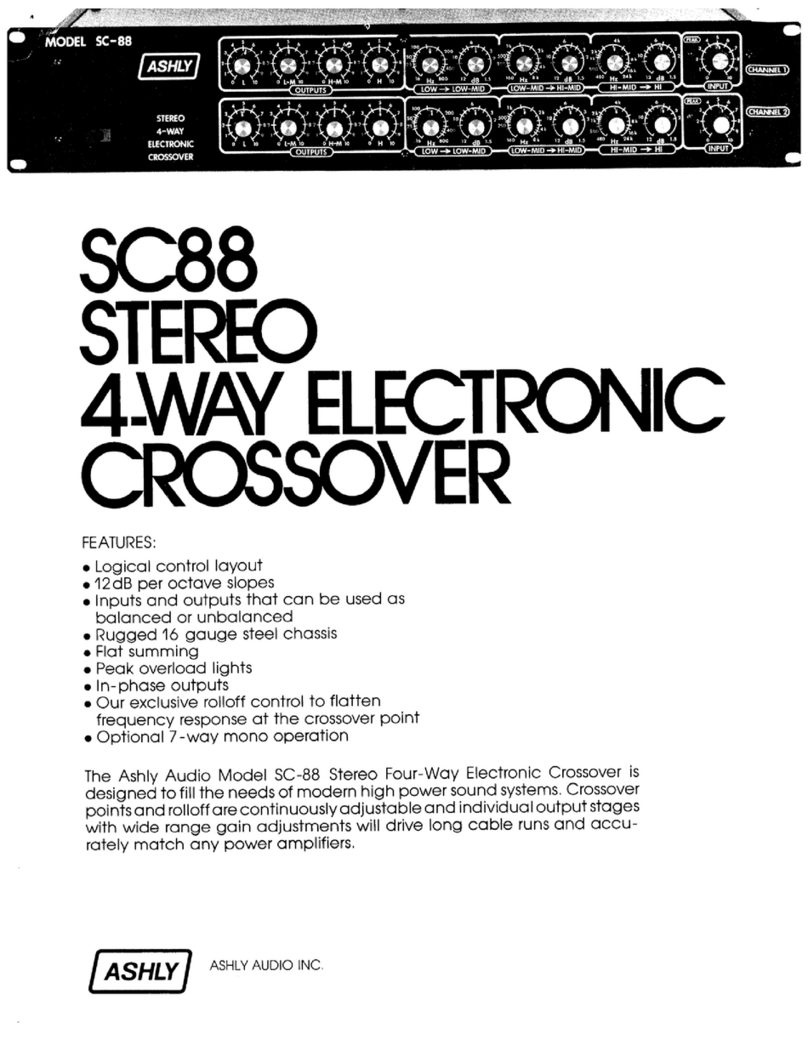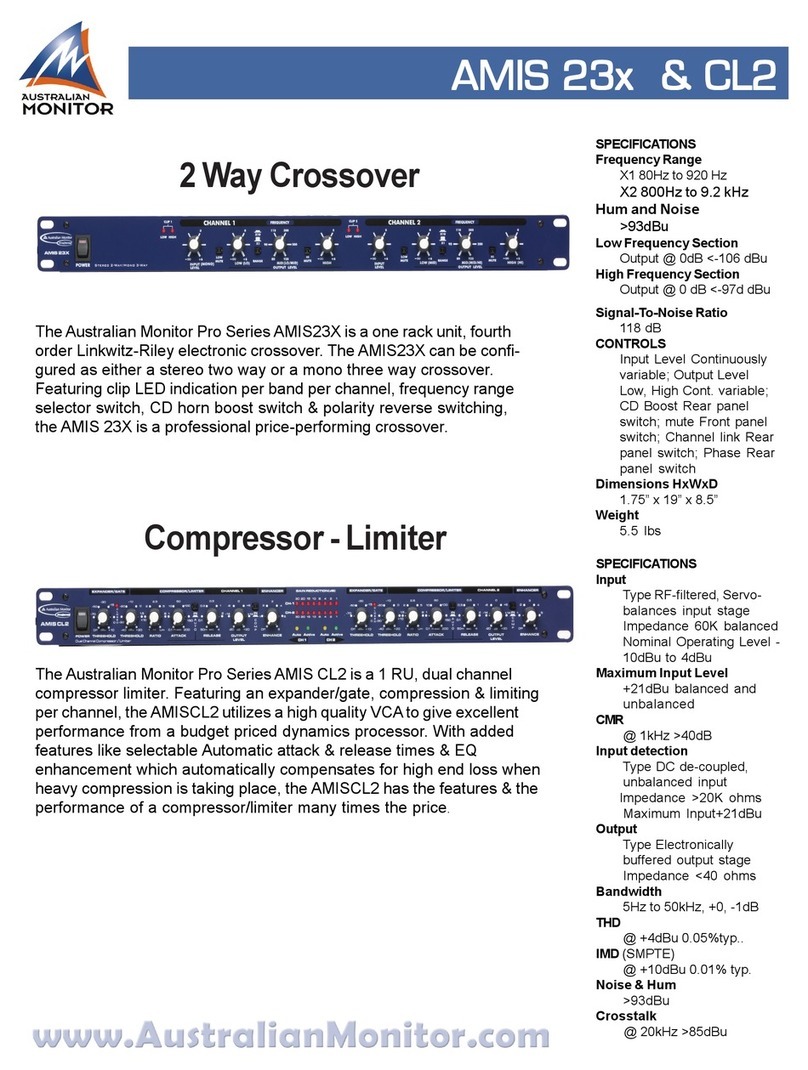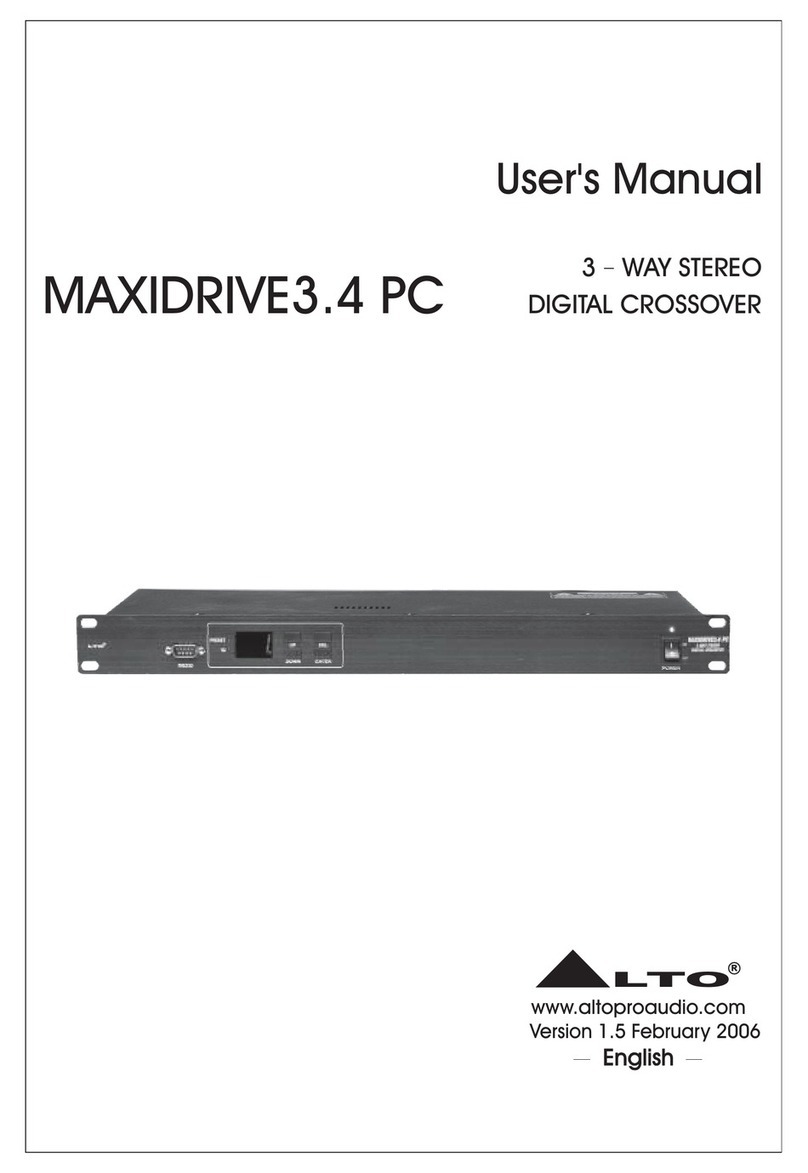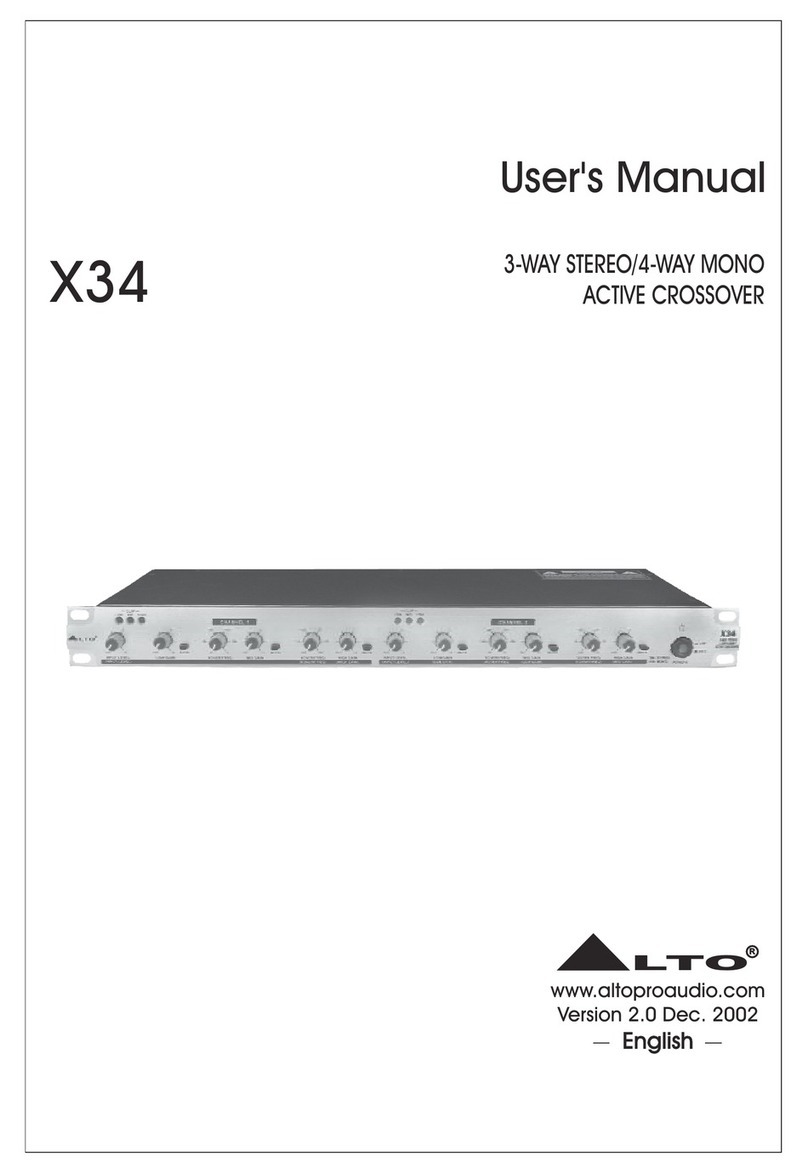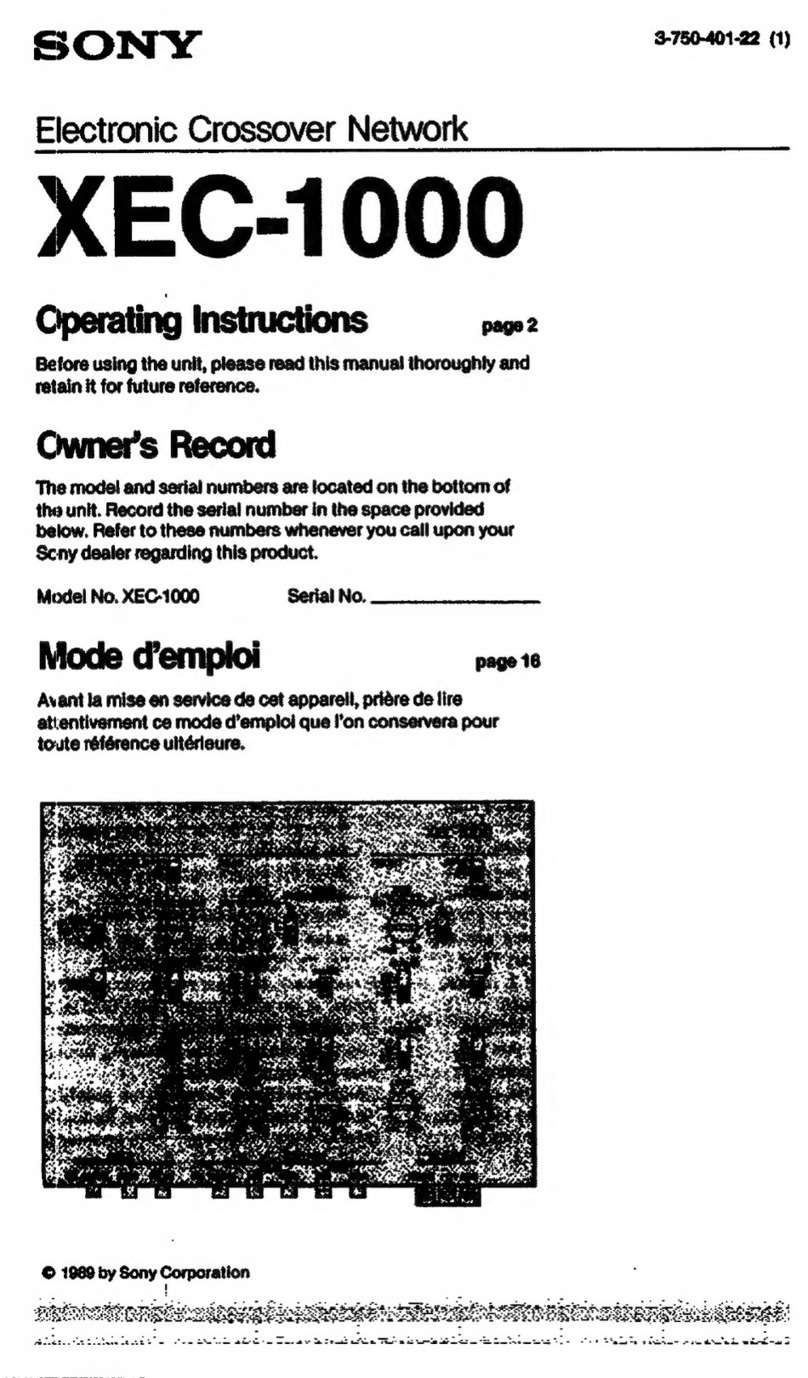Phonic i7200 XrossTech User manual

V1.3 2004/9/15

1. Read these instructions before operating this
apparatus.
2. Keep these instructions for future reference.
3. Heed all warnings to ensure safe operation.
4. Follow all instructions provided in this document.
5. Do not use this apparatus near water or in locations
where condensation may occur.
6. Clean only with dry cloth. Do not use aerosol or
liquid cleaners. Unplug this apparatus before
cleaning.
7. Do not block any of the ventilation openings. Install
in accordance with the manufacturer
’
s instructions.
8. Do not install near any heat sources such as
radiators, heat registers, stoves, or other apparatus
(including amplifiers) that produce heat.
9. Do not defeat the safety purpose of the polarized
or grounding-type plug. A polarized plug has two
blades with one wider than the other. A grounding
type plug has two blades and a third grounding
prong. The wide blade or the third prong is provided
for your safety. If the provided plug does not fit into
your outlet, consult an electrician for replacement of
the obsolete outlet.
10. Protect the power cord from being walked on
or pinched particularly at plug, convenience
receptacles, and the point where they exit from the
apparatus.
11. Only use attachments/accessories specified by the
manufacturer.
12. Use only with a cart, stand, tripod,
bracket, or table specified by the
manufacturer, or sold with the
apparatus. When a cart is used,
use caution when moving the cart/
apparatus combination to avoid
injury from tip-over.
13. Unplug this apparatus during lighting storms or
when unused for long periods of time.
14. Refer all servicing to qualified service personnel.
Servicing is required when the apparatus has been
damaged in any way, such as power-supply cord or
plug is damaged, liquid has been spilled or objects
have fallen into the apparatus, the apparatus has
been exposed to rain or moisture, does not operate
normally, or has been dropped.
IMPORTANT SAFETY INSTRUCTIONS
CAUTION: TO REDUCE THE RISK OF ELECTRIC SHOCK,
DO NOT REMOVE COVER (OR BACK)
NO USER SERVICEABLE PARTS INSIDE
REFER SERVICING TO QUALIFIED PERSONNEL
"
CAUTION
RISK OF ELECTRIC SHOCK
DO NOT OPEN
The lightning flash with arrowhead symbol, within an
equilateral triangle, is intended to alert the user to the
presence of uninsulated
“
dangerous voltage
”
within the
product
’
s enclosure that may be of sufficient
magnitude to constitute a risk of electric shock to persons.
The exclamation point within an equilateral triangle is
intended to alert the user to the presence of important
operating and maintenance (servicing) instructions in the
literature accompanying the appliance.
WARNING: To reduce the risk of fire or electric shock, do
not expose this apparatus to rain or moisture.
CAUTION: Use of controls or adjustments or
performance of procedures other than those specified
may result in hazardous radiation exposure.
"

TABLE OF CONTENTS
Introduction............................................ 4
Features ................................................. 4
Intial Setup............................................. 5
Controls and Settings........................... 6
Indicators ............................................... 7
Back Panel ............................................. 8
Using the i7200 XrossTech...................9
Applications......................................... 12
Specifications...................................... 13
Page

PHONIC CORPORATIONI7200 USER’S MANUALPage 4
Introduction
Thank you for purchasing another one of Phonic's many
superior products. The i7200 XrossTech, a quality high
precision 2-way stereo, 3-way mono Digital Crossover,
supplies the power and efficiency you expect to find in a
quality Phonic product. As is the case with the rest of the
Phonic I series of Digital Signal Processors, the i7200
XrossTech will undoubtedly provide you with the reliability
needed for true professional audio processing.
The i7200 XrossTech, an extremely musical and flexible
Active Digital Crossover, features a 32-bit DSP, giving it
precise frequency control for stereo 2-way and mono 3-
way operation. In addition to supplying great flexibility in
configuring to different sound systems, the i7200 Xross-
Tech also features a fully functional compressor-limiter,
delay, subwoofer output, as well as individual Phase and
Mute buttons. With ultra-quick gain control for all chan-
nels, plus stereo link, ensuring convenient synchronizing
of functions on both stereo channels, and a factory preset
program as well as 60 user-definable program slots gen-
erously incorporated, the i7200 provides you with ease
and accuracy only found in Phonic products.
This user's manual is specially designed to provide you
with the best possible information on using the device.
We strongly suggest reading the manual carefully before
even attempting to handle this device, and then store it
an easily accessible place for future reference.
Features
z24-bit A/D and D/A converters with 256/512 times
oversampling for high headroom and resolution
zInternal 32/40 bit floating processing with profes-
sional 48kHz sampling rate
zPerfect flat summed amplitude response at all
crossover frequencies
zLimiters and compressors with variable time param-
eters
zExtremely accurate attack time from zero millisec-
onds
zMute buttons on all outputs for troubleshooting
z1 factory preset and 60 user presets available
zTime/phase alignment via polarity switches and 20
millisecond time delay
zGroup delay < 900µs
zIlluminated buttons and LED indicators on all impor-
tant functions for easy status identification
zHigh precision components ensure excellent quality
and accuracy of settings
zUser-friendly operation plus immediate display and
parameter tuning
zBalanced XLR and 1/4” TRS outputs
zBalanced combo jack inputs
zAccurate 10-segment LED level meters simplify
level setting for optimal performance

I7200 USER’S MANUALPHONIC CORPORATION Page 5
Intial Setup
1. Use the supplied power cord to connect the i7200 to
an AC power outlet of a suitable voltage.
2. Connect the left and right main outputs of your mixer,
or other appropriate audio output device, to the CH
1 and CH 2 analog-in ports.
3. Connect the CH 1 and CH 2 analog out ports to an
amplifier and, intern, a pair of speakers, or other
appropriate output device.
4. Turn the power switch of the i7200 on - look on the
right side of the device. No, no, the other right. Yes,
that s the one.
5. You're ready to go! Select a crossover frequency
(or frequencies), set the input and output signal levels,
compensate for out of phase operations, adjust the
time delay of outputs and set compressor/limiters for
a clear, distortion-free sound; or simply recall a preset.
Don't know how? Well, turn the page and read on.
Why Should I Use the Phonic
i7200 XrossTech?
Crossovers, like the XrossTech, are specifically used to
separate different frequency ranges of audio into their
own distinct outputs; ensuring the correct speakers are
used to reproduce the most appropriate audio signals. For
example, subwoofer speakers are best used in conjunc-
tion with low frequency sounds, as subs are specifically
designed to produce the best quality bass. However, hav-
ing a high frequency signal fed through to a subwoofer
can not only be horrible sounding, but also, due to the
greater oscillating range of higher frequencies, can cause
irreversible damage to the speaker.
Enter the XrossTech. The Phonic i7200, a 2-way stereo,
3-way mono crossover, that gives you precise control
over the crossover frequency (ie. the frequency at which
the audio will be divided into separate frequency ranges)
or frequencies, and incorporates a great number of addi-
tion features, ensuring your audio not only sounds good,
but treats your speakers in a responsible manner too.

PHONIC CORPORATIONI7200 USER’S MANUALPage 6
Controls and Settings
1. Level Meters
The dual LED level meters allow you to read the input
signal level in dB, referenced to the internal digital maxi-
mum. This will provide an indication as to the amount of
headroom available until the audio reaches the maximum
digital input level and is dynamically clipped.
2. Input Level Control
By turning this control you are able to adjust the main
input level at a range between -50 and +12 dB, as well
as OFF (if you turn past the -50 mark). Pushing this
control allows you to switch between the Channel 1 and
2 inputs, as shown by the corresponding CH1 and CH2
indicators (your alterations are, of course, made to the
Channel with an illuminated LED). The level changes will
be displayed on the Numeric Display, which will revert
back to the preceding display two seconds after complet-
ing level alterations.
3. Mute Keys
Individual outputs can be shut completely off with the
quick press of the corresponding muting buttons, which
will be accompanied by an illuminated LED indicator
within the button. Just a handy little feature for when
you really want to deactivate those outputs in a rush!
4. 7-Segment Numeric Display
This clearly legible, numeric digit display will show details
of the properties last edited, gives a clear indication of
values that are being altered, and has plus/minus indica-
tors to show whether parameters are positive or negative
in value. The various parameter indicators (Hz - hertz
- kHz - kilohertz - dB - decibel - PRE - preset - ms - mil-
lisecond - sec - second - and ø - phase) on both sides
of the display are illuminated when their corresponding
applications are being displayed or edited. For example,
if you raise the input or output level of any channel, the
dB (decibel) indicator lights up.
5. Store Key
Any modifications made to a preset can be stored by
using this key. There are sixty user-definable slots avail-
able.
6. Phase Key (ø)
This key is used to select an in or out phase operation,
allowing you to select and set each of the individual output
channels. When selecting the Phasing of a channel, the
indicator on the main numeric display will illuminate.
7. Preset Key (PRE.)
When the preset indicator is illuminated you are able to
use the function jog wheel to select the factory preset
or one of sixty of your own personally stored presets.
When selecting or using a preset, the PRE. indicator on
the main numeric display will illuminate.
8. Delay Key
When this key is pushed, the user is then able to adjust
the delay of the corresponding channel between 0 and
20 milliseconds, for time alignment of all outputs. When
selecting the delay, the ms (milliseconds) indicator on
the main numeric display will illuminate.
9. XOVER / EDIT Jog Wheel
This jog wheel is used for the editing of most functions.
Pushing inwards finalizes any alterations you have made.
If you do not push to finalize, any changes you make with
the XOVER/EDIT jog wheel will not be saved!
10.Compressor Key
This key is used to activate the inbuilt Compressor, which
provides more punch to the audio, and helps avoid distor-
tion and provides more punch to audio. After pressing the
Compressor Key, you are then able to use the XOVER/
EDIT jog-wheel to select the threshold, ratio, attack, and
release rates, as will be explained later in the manual.
11. Limiter Key
This key is used to activate the inbuilt Limiter function,
which provides maximum output, while offering extended
speaker protection. Pushing the Limiter Key repeatedly
allows you to alternate between the threshold and release
indicators. You are then able to use the XOVER/EDIT jog
wheel to select the threshold and release rates, as will
be explained later in the manual.

I7200 USER’S MANUALPHONIC CORPORATION Page 7
12. X-OVER Key
This control is used to allow you to select the crossover
frequency of the selected channel. Pushing it numerous
times in a row allows you to alternate between XOVER
1 and XOVER 2 when set in 3-way mono. Holding the
X-OVER key down for 3 seconds enters you into a menu
that will allow you adjust the slope of the crossover curve
between 6, 12, 18 and 24 dB per Octave.
13.CH / SEL Key
Simply pushing this key will alternate between the 2 chan-
nels when in Stereo mode. Depending on which of the
CH indicators is illuminated, you are then able to alter the
properties of the corresponding channel. Turning the X-
OVER/EDIT jog wheel while holding this button down al-
lows you to select either the LINK/ST or M/3WAY modes,
which allow both channels to be edited simultaneously
or activate 3-way mono mode, respectively.
NB. When changing to Link Stereo or 3-Way Mono mode, the device will
automatically mute all output channels. These mutes must be manually
deactivated.
14.OUT GAIN Jog Wheel
Used to tune the output gain level at a cut and boost rate
between +12 to -50 dB. Turning past the -50 dB mark
will enable a mute of the corresponding output channel,
accompanied by the word OFF on the display. Pushing
the OUT GAIN Jog Wheel will switch between editing the
low, middle, high and subwoofer outputs (high and low
only for Stereo), as indicated below this control.
15.Power Switch
Use the Power switch to turn the XrossTech on or off
simplicity at its finest.
Indicators
16.L1, L2, H1, H2 Indicators
These LEDs illuminate when
selecting the Phase operation of
those particular channels. They,
of course, stand for Low 1, Low
2, High 1 and High 2.
17.Sub Indicator
This LED illuminates when selecting properties of the ad-
ditional subwoofer output, when in 3-way mono mode.
18.XOVER1 and XOVER2 Indicators
These indicators illuminate when selecting the crossover
frequency of the selected channel. XOVER2 is only used
when in 3-way mono mode.
19.Threshold Indicator
This indicator is used in conjunction with the built-in Com-
pressor and Limiter functions. When flashing, it allows the
user to adjust the Threshold of the previously selected
function at a range between -50 and 0 dB.
20.Ratio Indicator
This LED will flash when selecting the ratio of compression
used, between 1:1 and ∞:1 (which will be displayed as
INF on the Numeric Display).
21.Attack Indicator
This LED will flash when selecting the rate of Attack of
the compressor function. You are then able to select the
attack rate between 1 and 200 milliseconds, in 1 mil-
lisecond steps.
22.Release Indicator
This LED will flash when selecting the Release rate of
the compressor or limiter functions. You are then able
to select the rate of release between 10 and 500 mil-
liseconds, in 5 millisecond steps, then between 0.5 and
5 seconds in 20 millisecond steps.
23.CH 1 and CH 2 Indicators
Either one of these will illuminate when the corresponding
channel is selected using the CH Key.
24.Link / St Indicator
When this indicator is illuminated, all changes you make
to the properties of the XrossTech will be applied to both
output channels. Any changes already made to chan-
nel 1 will automatically be applied to channel 2 when
selected.
25. M / 3WAY Indicator
This indicator is selected to enable the 3-way mono
function of the i7200.

PHONIC CORPORATIONI7200 USER’S MANUALPage 8
Back Panel
26.Channel 1 Input
These balanced combination connectors accept either
professional 3-pin XLR or 1/4 TRS inputs.
27.Channel 1 Low Output (Mono Sub Output)
Feature both professional 3-pin XLR and 1/4 TRS bal-
anced line outputs. This output is used in conjunction
with speakers suitable for low frequency reproduction
of audio when in stereo mode, and acts as an optional
subwoofer output when in mono operation.
28.Channel 1 High Output (Mono Low Output)
Feature both professional 3-pin XLR and 1/4 TRS
balanced line outputs. This output is used to connect
speakers suitable for high frequency reproduction of au-
dio when in stereo mode, and acts as a Low frequency
output when in mono mode.
29.Channel 2 Input
These balanced combination connectors accept either
professional 3-pin XLR or 1/4 TRS inputs.
30.Channel 2 Low Output (Mono Mid Output)
Feature both professional 3-pin XLR and 1/4 TRS bal-
anced line output. This output is used to connect speakers
suitable for low frequency reproduction of audio when
in stereo mode, and for mid-range speakers when in
mono mode.
31.Channel 2 High Output (Mono High Output)
Feature both professional 3-pin XLR and 1/4 TRS bal-
anced line output. This output is used to connect speakers
suitable for high frequency reproduction of audio when
in both stereo and mono modes.
32.AC Power Cable Connector
Connect the supplied AC power cord to this connector,
and insert the power plug into a wall-socket of suitable
voltage.

I7200 USER’S MANUALPHONIC CORPORATION Page 9
Using the i7200 XrossTech
Selecting Stereo or Mono Mode
As you have probably worked out by now, the i7200
XrossTech is a 2-way stereo, 3-way mono digital cross-
over. This means, in stereo mode, you are allowed a total
of 2 output channels - each with a different user-defin-
able crossover frequency - and in mono mode, you can
choose 2 crossover frequencies for the single channel
available. Mono mode, however, does feature a sepa-
rate Subwoofer connection, allowing a total of 4 speaker
outputs in both Stereo and Mono modes.
Link Stereo
When using stereo mode, you can alternate between
channels 1 and 2 by pushing the CH/SEL Key, allow-
ing you to adjust those particular channels properties
separately (as described later in the manual). It is
also possible to adjust both channels simultaneous
by holding the CH/SEL button, then turn the XOVER/
EDIT jog wheel to scroll down to the LINK/ST indica-
tor. This causes any adjustments made to Channel
1 to be applied to Channel 2 also.
3-Way Mono
To select the 3-way mono function, first press and
hold the CH/SEL Key, then rotate the XOVER/EDIT
jog wheel to scroll down to the M/3-WAY Indicator
and press the jog wheel. You are now in mono mode.
To return to stereo mode, just follow the same rou-
tine, and scroll up to the CH 1, CH 2 or LINK/ST
indicators.
Automatic Muting
When entering into either the link stereo or 3-way
mono modes, a mute of all output channels is acti-
vated and must be manually deactivated before any
audio signal will be sent through these outputs. This
ensures total protection of speakers when entering
into a mode that could prove potentially dangerous
to them.
Selecting Crossover Frequencies
Selecting the frequency at which the audio will be di-
vided is relatively simple. In stereo mode, you should
first press the X-OVER Key, then, using the XOVER/EDIT
jog wheel, adjust the frequency between 250 Hz and 10
kHz. All frequencies below your crossover frequency will
be sent to the low output of the selected channel, and all
frequencies above will be sent to the high output of the
selected channel. In mono mode, you are actually able
to select 2 crossover frequencies on a single channel.
This means you will be outputting low frequencies and
high frequencies, as well as middle frequencies. To do
so, first press the X-OVER Key. Doing this repeatedly
will alternate between XOVER 1 and XOVER 2, as the
LEDs will indicate.
NB. The Crossover frequency of XOVER 2 will not exceed that of XOVER
1, providing protection against using excessive frequencies with
incorrect speakers.
A 'Butterworth' Curve
The i7200 XrossTech allows the user to select the angle
of the curve (created in true Butterworth style) of every
frequency range's signal (ie. the Highs, Lows and Me-
diums each share the same curve shape). To select the
curve angle, simply press and hold the X-OVER key
continuously for three seconds. The Numeric Display
will then show F, followed by the currently used setting.
By turning the XOVER/EDIT jog wheel, you can then
select the curve from either 6, 12, 18 or 24 decibels per
Octave (where 18 dB is the default setting).
Inverting the Phase
By pressing the Phase button, you are able to select
from the 4 separate output channels. Continually pushing
the button will allow you to scroll through these differ-
ent output channels, and turning the XOVER/EDIT jog
wheel enables you to invert the phase of that particular
frequency. This will ensure any out-of-phase outputs are
once again synchronized with one another. This is useful
as to avoid having to rewire out-of-phase speakers, in
correcting for differences in inappropriately positioned
speakers, and in correcting differences created by the
use of a delay.
NB. When selecting the Phase and Curve Shape, the XOVER/EDIT jog
wheel must be pushed to confirm your setting.
Using the Compressor Function
Using the i7200's built in compressor enables you to
ensure your audio is always of the highest quality and
utterly free of distortion. In essence, a compressor re-
duces the level that the audio increases or decreases
at any time, provided of course that the level is above
the selected threshold. For example, if the audio signal
was to be increased by 1.5 dB, it may only be increased
by 1.1 dB when using a compressor - depending on the
ratio chosen by the user. The compressor effectively
reduces the dynamic range of the audio signal, thus
avoiding speaker overload and ensuring the production
of perfect, distortion-free audio, as well as add more
punch to your sound.

PHONIC CORPORATIONI7200 USER’S MANUALPage 10
To activate the compressor, first push the Comp Key.
Pushing this button repeatedly will allow you to alternate
between the Threshold, Ratio, Attack and Release indica-
tors, and by simply rotating the XOVER/EDIT jog wheel
you are then able to adjust the properties of these at the
rates described below.
Threshold – the threshold is the level (selectable in dB)
at which you wish to begin compression. Any frequency
below your chosen threshold will be unaffected by the
i7200's compressor. The Threshold level is selectable
between -50 and 0 dB.
Ratio – this allows you to select the ratio at which com-
pression will occur after the level has increased passed
the threshold. For example, if your selected ratio is 2:
1, any 2 dB increase in your audio signal will only be
increased by 1 dB. The ratio of the i7200's built-in com-
pressor is selectable between 1:1 and ∞:1.
Attack – this will adjust the rate of attack, which es-
sentially allows you to decide how long the compressor
will wait after an audio signal has increased beyond the
threshold until the compressor kicks into action. You are
able to select the attack rate between 1 and 200 mil-
liseconds, adjustable in 1 millisecond steps.
Release – this will adjust the compressor's rate of re-
lease, which is basically the opposite of the attack rate.
The release rate is the amount of time the compressor will
wait after the audio signal drops below the threshold until
the compressors stops squashing your unfortunate audio
signal. You are able to select the rate of release between
10 and 500 milliseconds in 5 millisecond steps, then be-
tween 500 and 5 seconds in 20 millisecond steps.
NB. When the ratio of the Compressor is set at 1:1,the compressor is
then, effectively, disabled. If you wish to turn the Compressor off,
this ratio should be applied. Also, when selecting the Threshold,
Ratio, Attack, and Release rates, the XOVER/EDIT jog wheel must
be pushed to confirm your setting.
Using the Limiter Function
A limiter is essentially a compressor with a fixed com-
pression ratio; in the case of the i7200's limiter, the ratio
is fixed as ∞:1, in essence ensuring no audio increases
past the selected threshold. Setting up of the limiter is
accomplished in the same way as the compressor, by
first pushing the Limiter Key, followed by the use of the
XOVER/EDIT jog wheel to alter the threshold and release
properties.
Input Signal (dBu)
Output Signal (dBu)
&RPSUHVVRU
2XWSXWOHYHO LQSXWOHYHO
&RPSUHVVRU
7KUHVKROG
/LPLWHU
7KUHVKROG
/LPLWHU
It may be desirable to use both the compressor and
limiter simultaneously, first activating the compressor,
to reduce the increases in the audio level, then the
limiter, actively stopping signals from increasing above
a selected level.
NB. If you wish to turn the Limiter off, you should set the threshold at 0
dB, which will cut off all frequencies above this level. This will give
you a great dynamic range of audio.
Muting Channels
Muting can be accomplished by pushing the one of the
muting buttons on the face of the i7200. Pushing the mute
button that corresponds with the output you wish to mute
will not only halt any signal being sent to that particular
output, but will also be accompanied by an illuminated
LED. Pushing the same button will deactivate the muting
of that channel.
Selecting the Delay
Depending on the positioning of speakers in relation to
one another (among other contributing factors) it may
be necessary to activate a short delay on certain output
channels. The delay is selectable by first pressing the
Delay button on the face of the i7200. Then, by using the
XOVER/EDIT jog wheel, select the rate of delay between
0 and 20 milliseconds. This can be done separately for
each individual output channel.
NB. When selecting the Delay, the XOVER/EDIT jog wheel must be
pushed to confirm your setting.

I7200 USER’S MANUALPHONIC CORPORATION Page 11
Using a Subwoofer
When in 3-way mono, it is possible to connect a sub-
woofer to the extra output, unused in the typical High,
Mid and Low output configuration. To do this, first set the
device to 3-way mono. By repeatedly pressing the OUT
GAIN jog wheel in, the i7200 will alternate between the
Low, Mid, High, and eventually Sub indicators. When
the Sub indicator is illuminated, you can then rotate the
XOVER/EDIT jog wheel to select the cut off frequency
between 25 Hz and 250 Hz and press the jog wheel to
finalize your selection. All frequencies below the selected
cut off will be sent to the Sub output. You are also able
to adjust the Output Gain of this level. To do so, simply
turn the OUT GAIN control.
Recalling and Saving Presets
By first pressing the Preset Key, you are able to use the
XOVER/EDIT jog wheel to select the factory preset, as
well as select from sixty of your own personally stored
presets. To store your own settings, first set all the
properties of the i7200 to your needs. Once you have
completed your settings, press the Store Key, which will
cause the LCD screen to show U 1 (User Preset slot 1).
You can then use the XOVER jog wheel to choose from
U 1 to U 60 and click the XOVER jog wheel to save in the
chosen slot. You are then able to change your settings
and recall the previously saved settings at any time. The
convenience of having your settings saved in the device
frees you from having to spend time adjusting properties
each time you use it.
If you recall a preset with a different channel setting than
you are currently using (eg. If you are in Stereo Mode
and choose a Mono preset) a mute of all channels will
activate immediately to protect speakers from receiving
the incorrect frequency ranges.
NB. When recalling presets, the XOVER/EDIT jog wheel must be pushed
to confirm your setting.
Auto Saving Settings
If the controls of the i7200 are not used for a ten second
period, the system will automatically save your current
settings, which will be stored and kept even after the
device is turned off. This ensures no settings are lost in
the event of power outages.
Locking the i7200
By pressing any two of the jog wheels located on the
front of the i7200 simultaneously you enable a key lock
that will stop any settings from being accidentally altered
while the device is in use. To disable this lock, once again
press any two jog wheels.

PHONIC CORPORATIONI7200 USER’S MANUALPage 12
Applications
2-way Stereo
3-way Mono

I7200 USER’S MANUALPHONIC CORPORATION Page 13
Specifications
INPUTS
Type Electronically balanced, RF filtered
Impedance Balanced > 50 K ohms
Maximum Input Level +16dBu, balanced
CMRR >40dB
OUTPUTS
Type Electronically balanced, RF filtered
Output Impedance Balanced 200 K ohms
Maximum Output level +16 dBu, balanced
SYSTEM PERFORMANCE
Frequency Response 10Hz to 20KHz, +0/-3 dB
THD < 0.006% at +4 dBu, 1 KHz
Noise <-70dBu (20Hz to 20KHz, flat)
Crosstalk < -80 dB, 20 Hz to 20 KHz
Processing Latency < 1.5 ms
DIGITAL PROCESSING
Converters 32-bit Sigma-Delta, 512/128-times oversampling
Sampling Rate 48 KHz
CROSSOVER FREQUENCIES
Stereo Mode
Low/High 80 Hz to 10 kHz,
Mono Mode
3-way Low/Mid/High 80 Hz to 10 kHz,
COMPRESSOR/LIMITER
Threshold range –50 to 0 dB
Attack 0 to 200 ms
Release 10 to 5000 ms
Ratio 1:1 TO 1 INF:1
Delay
Maximum delay time 60ms, independently adjustable for each channel
LEVEL DIGITAL SELECT
Input Variable from -∞to +12dB
Output / Sub-Low-Mid-Hi Variable from -∞to +12 dBu
PHASE INVERT
Type +/- 180°compensate
MUTE CONTROL On 4 outputs, with indicator.
SUB MODE Use output gain function to select, only in 3-way mode
Sub frequency 25Hz to 250Hz
PROGRAM 1 preset and 60 program store
DISPLAY
Type 7 segment numeric LED Display
Indication 3 channel status select, 2 x-over, 4 compressor-limiter, 4 phase, 1 sub, 2 delay, 5 input/output level
FRONT 12 function keys / 1 parameter edit / 2 level control select
REAR 2 INPUT (combo jack), 4 OUTPUT (XLR), 1/4 phone jack
POWER SUPPLY
Mains voltage 100-120, 220-240V AC, 50~60Hz
Fuse 1A (100~120VAC), 500mA(200~240VAC), slow blow
Power consumption 20 W
PHYSICAL
Dimensions (W x H x D) 51.3 x 482 x 207.6 mm (2.02” x 18.98” x 8.17”)
Weight 2.6 kg (5.7 lbs)

PHONIC CORPORATIONI7200 USER’S MANUALPage 14
NOTES

I7200 USER’S MANUALPHONIC CORPORATION Page 15

Information in this document is subject to change without notice.
Table of contents
Other Phonic Crossover manuals
